|
The following is an example of a common memory module. This is a stick of DDR3. This is the current type of memory being used in most motherboards. Before this (in recent years) there was DDR2 and before that DDR. This example has a heat spreader on it. This is common on higher-performance memory. Most of the memory in use has no heat spreader so the memory ICs are visible on the circuit board. Examples of other memory modules can be found at the bottom of this page.

The label tells you that this is DDR3-1600. This means that it's capable of being used in a system with a 1600MHz front side bus (FSB). Sometimes, the labels don't have DDR3 on them and only have PC3-... PC3 is DDR3. PC2 is DDR2. The label has 4GBx2 on it. That can be confusing because this is a single 4GB stick of RAM. Memory can be purchased in pairs to be used in motherboards with dual channel memory controllers. When using memory in dual channel boards, the best performance will be achieved if the memory modules match. When you buy a dual channel kit, the memory modules are tested and matched closely enough to work well together.
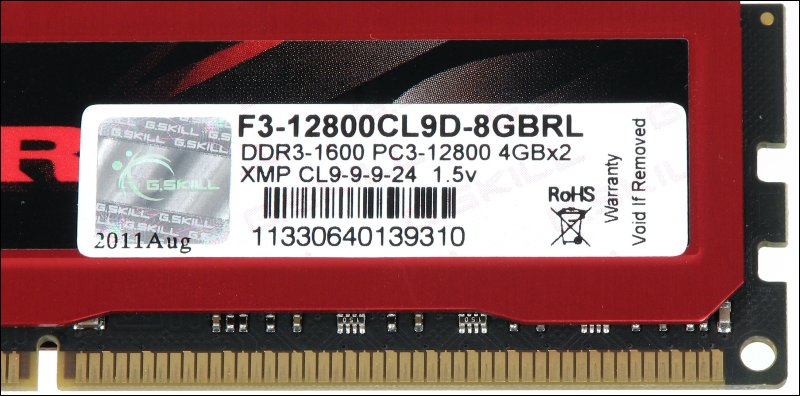
The label above also gives the timing specs for the memory (9-9-9-24-2N). For most users, these aren't important because the motherboard will recognize the memory and set the timings correctly. For some motherboards, the automatically settings don't match these numbers and you have to go into the bios (to be covered later in the tutorial) and set them manually. The XMP indicates that it is designed to be used with the Intel Extreme Memory Profile systems. The 1.5v indicates the rated voltage.
Memory Specifications
Speed:
This is simply the speed at which the memory is rated to run. For your processor to run at it's full potential, you need memory that's rated to run as fast as or faster than the FSB (Front Side Bus) speed of your processor. Processors WILL run on memory rated slower than their FSB speed but they will not run as fast. If your memory is rated at DDR3-1600 (PC3-12800), it's rated to run on a 800MHz FSB. Since it processes data on both the rising and falling edges of the clock pulse, it acts as 1600MHz RAM. The PC3-12800 indicates that the data throughput is 12.8Tb per second.
The DDR part of the name means that it can read/write data at twice the memory bus speed. For example, this memory is rated at 333MHz. This means that the bus speed is 166MHz. It can pass data at twice the bus clock speed because it processes data on both the rising AND falling portions of the clock pulse. Older memory could only process data on the rising OR falling side of the clock pulse. You will also see DDR-333 RAM labeled as PC2700 RAM. The 2700 in PC2700 means that it can process 2.7GB (2.7 billion bytes) of data per second.
Cas Latency:
The CAS latency tells how many clock pulses will occur between various operations in the memory. Lower numbers are better. Unless you're into over-clocking, these numbers are of little concern. Buy memory that's made to run at the correct speed for your system and you won't have any problems.
Support Voltage:
This is the voltage on which the memory operates.
Maximum Memory that can be Installed:
The maximum amount of memory that can be installed is limited by several things. The first is your motherboard. Some cannot use more than 16GB of memory. Others can handle much more. The owner's manual for the motherboard will tell you how much can be installed and what's the maximum per slot (generally the maximum amount of memory divided by the number of slots). There is something else to consider, however. Besides hardware limitations, there are also software limitations. In Windows 7, for example, the 32 bit versions are limited to 4GB. The 32 bit starter version of Win7 is limited to 2GB. The 64 bit versions of Win 7 can all handle at least 8GB and some can go to 192GB.
NOTE:
Virtually all computer circuit boards and cards are static sensitive. In some areas, static electricity is a huge problem. The problem tends to be worse in cool, dry climates but everyone, no matter their location, has experienced static discharge. Even though you don't realize, there are discharges that are too insignificant to feel but they happen. These small discharges are still in the range of hundreds of volts. Since many of the electronics components on a circuit board can be damaged by as little as 20 volts, even a very small static discharge can be harmful to your computer components. If you have to work on your computer (for example, if you add memory to your computer), you will need to avoid dangerous static discharge. One way to do this it to make sure that you are in contact with your computer at all times. When working on your computer, try to keep one hand or arm in contact with the metal case (the computer will be unplugged, of course). When you pick up a computer component, you pick it up by its package ('static sensitive' bag or other conductive enclosure). While removing it from its package, don't lose contact with the computer case. Until the memory (or other component) is in it's slot and locked down, do not let go of the case. If you have to let go of the case and the component is not yet installed, put it back into its package or set it into the bottom of the computer case on top of the conductive package. If it's never been installed, it's OK to set it directly into the bottom of the computer case. Before touching the device, again make contact with the computer's case. I know that this sounds like a pain but you can easily damage an expensive card without even knowing.
Virtual Memory:
Virtual memory is employed when the physical memory (RAM) has insufficient capacity to handle the programs running on the computer. Older operating systems like XP could run on as little as 128MB of RAM and as long as you didn't open any large programs, the system would run relatively efficiently/quickly. Unfortunately, there is a need for complex programs if you're going to use the computer for anything more complex than creating simple text files. If you're going to be connected to the internet via an ethernet connection, you would, at the minimum, need an anti-virus program running. That alone would likely take up any reserves that the 128MB of RAM had free. When Windows begins to run out of free RAM memory, it uses what's called 'virtual memory'. It takes the files that would have been written to RAM and writes them to the hard drive. As it needs what's stored in virtual memory on the drive, it moves it from the virtual memory to RAM. In theory, this sounds like a good idea, and it works, but writing to and reading from the hard drive is MUCH slower than writing to and reading from RAM. This is especially true when you're using multiple programs that have to access their own memory files. Files have to be repeatedly shuffled back and forth from the hard drive to RAM.
The same rules apply to XP but the newer operating systems like Windows Vista or Windows 7 require much more memory. When Microsoft recommends a minimum of 1GB for Windows 7 (32 bit version), that's barely enough to make it run smoothly when you have only a few other programs running. When you have multiple programs open (graphics editors, document editors, web browsers...), the computer requires more memory to run smoothly. For older computers, having to write to virtual memory (due to a lack of physical memory) slowed things down a bit. With the newer, faster multi-core processors, having to use virtual memory makes the computer MUCH slower. As an example, a computer running a 4-core AMD Phenom processor with Windows 7 (64 bit version) and 1GB of memory wasn't much faster than a 5 year old computer running XP with 2GB of physical memory. After upgrading to 4GB of memory, the newer computer became lightning fast compared to the older computer (as it should have). The virtual memory (even when using fast hard drives) should be used as little as possible. if you're using Windows 7, I'd recommend a minimum of 2GB of memory. For the 64 bit version, 4GB would be a better choice.
VERY Important:
Before you attempt to change the virtual memory (next paragraph), you need to make sure that you have enough RAM for the OS to function at a basic level. For XP, I'd recommend a minimum of 2 gigabytes. For the 32 bit version of Win7, I'd recommend a minimum of 2 gigabytes of memory. For the 64 bit version of win7, I'd recommend a minimum of 4 gigabytes of RAM. If you have less RAM than this for any of these operating systems and you disable the virtual memory, the system may not boot up.
Changing Virtual Memory:
In the past, some people would disable virtual memory to try to help the performance of their computer. With newer operating systems, that may no longer be useful. However, it's possible that allowing the operating system to set the virtual memory that the virtual memory (pagefile.sys on C drive, or any other drive) may allow it to become too large taking up too much hard drive space. This is especially important for those who have converted to solid state hard drives (which will tend to be relatively small for the next few years, due to high cost/gigabyte of storage). As an example, there was a computer with a 64GB solid state drive and 16GB of RAM. Allowing Windows 7 to set the size resulted in a pagefile.sys file of 16GB. Add a hiberfil.sys file of 12GB and you can see that they occupied quite a large percentage of the 64GB drive. Setting the page file to 1000-2000MB prevented the pagefile.sys file from getting too large (limited to 2GB -- 2000MB).
In XP, right-click on 'My Computer' and select properties from the dialog box. That will bring up the system properties dialog box.
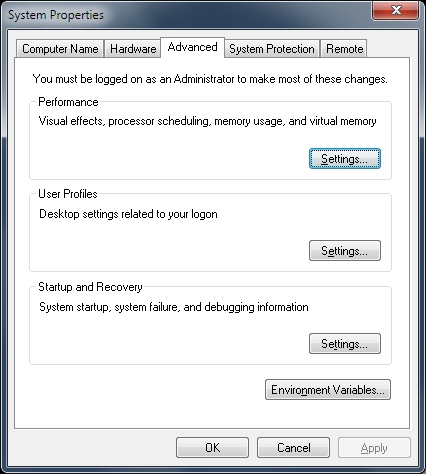
In the PERFORMANCE OPTIONS DIALOG BOX, select the ADVANCED tab again. In the VIRTUAL MEMORY section, select SETTINGS.
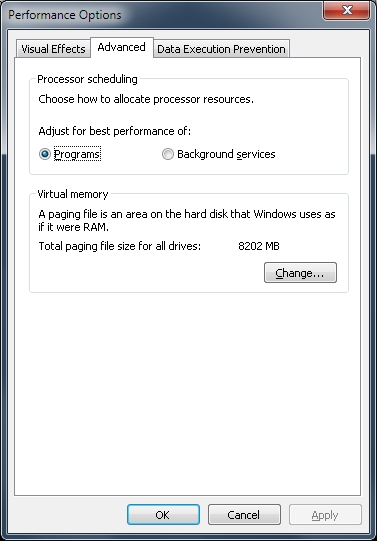
In the VIRTUAL MEMORY dialog box, you will see a list of the drives available to be used for virtual memory. To change the virtual memory, you will need to highlight a drive by clicking on it. You'd then choose one of the options below. To switch the virtual memory off, you'd select NO PAGING FILE and then click SET. To limit the pagefile size, use the custom setting and set the limits 1000MB and 2000MB. After making the changes, exit all of the dialog boxes by clicking OK. The computer may have to be restarted after making the changes. After restarting, if you have set all virtual memory to 0, you will have to go delete the pagefile.sys files to free up the hard drive space they occupied. Again, do NOT try this if you don't have significant physical memory (1GB for XP and 2GB for Windows 7 - as an absolute minimum).
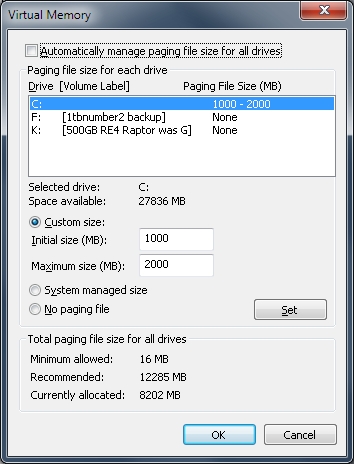
In Windows 7, you right click on my computer and select properties as in XP but you then see a different dialog box. In this box, you select ADVANCED SYSTEM SETTINGS. This brings up the same dialog boxes as you saw above for XP.
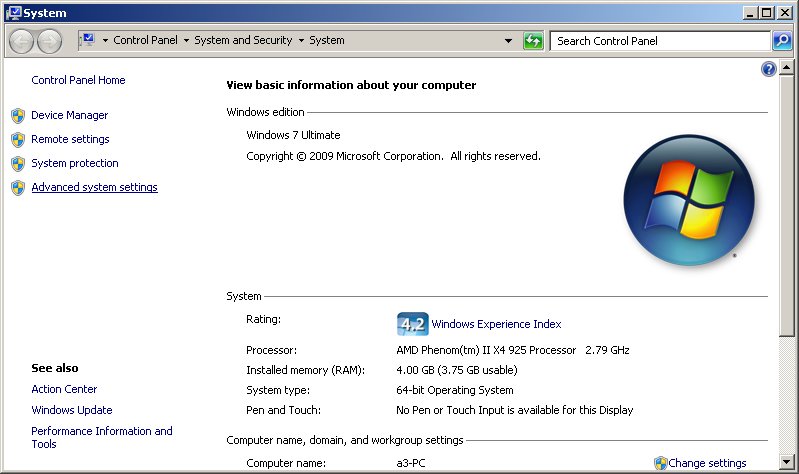
Hiberfil.sys:
If the hiberfil.sys file is taking up too much space on your hard drive and you don't use the hibernation feature, you can disable the feature and delete the file. I may cover that later but there is nothing on this site to tell you how to do that as of now. Use google and search for remove hiberfil.sys and include the operating system in the search terms. For example:
hiberfil.sys removal Windows XP
hiberfil.sys removal Windows 7
Examples of Other Memory Modules:
Below you can see a typical stick of RAM (Random Access Memory). This is a 184 pin module that can store 256MB of data. This is the most common type of RAM at this time (early 2005). As you can see by the sticker, this ram is DDR SDRAM (Double Data Rate Synchronous Dynamic Random access Memory).

The following memory module is DDR2 memory. It's a 240 pin module.

The following is DDR3 memory. It's also a 240 pin module. As you can see, the notch at the bottom of the module is in a different position, compared to the 240 pin DDR2. This prevents you from installing the wrong memory in a motherboard.

Memory that's designed for higher performance often has a heat-spreader or heatsink on the module. This helps dissipate heat. For most computers, this isn't important but for high performance computers (particularly those with over-clocked processors) it helps keep the operating temperatures low enough to make the memory reliable.

This next memory is old, virtually obsolete memory. It's a 128MB, 168 pin stick of PC133 SDRAM. This was used with the older Pentium 2 and 3 processors as well as other processors of that era. This type of RAM came in two significantly different variations. One was called a SIMM (Single Inline Memory Module). The other was a DIMM (Dual Inline Memory Module). They both looked pretty much the same except that the DIMM was actually 2 independent banks of memory. The DIMM's contacts were isolated from one side of the module to the other. The SIMM's contacts were connected through the circuit board (opposing contacts in the memory slot were actually connected together).

This is EDO ram and was used during the time of the first generation Pentium processors. As far as I know, it's no longer used in any of the motherboards being produced for the general public today.

|
You May Be Interested in My Other Sites
-
This site was started for pages/information that didn't fit well on my other sites. It includes topics from backing up computer files to small engine repair to 3D graphics software to basic information on diabetes.
-
This site introduces you to macro photography. Macro photography is nothing more than the photography of small objects. It can take quite a while to understand the limitations associated with this type of photography. Without help, people will struggle to get good images. Understanding what's possible and what's not possible makes the task much easier. If you need to photograph relatively small objects (6" in height/width down to a few thousandths of an inch), this site will help.
-
If you're interested in air rifles, this site will introduce you to the types of rifles available and many of the things you'll need to know to shoot accurately. It also touches on field target competition. There are links to some of the better sites and forums as well as a collection of interactive demos.
-
This site is for those who want to install or update their car stereo. It begins with the most basic electronics theory, progresses into basic transistor theory as well as covering virtually everything associated with car audio.
|
|











